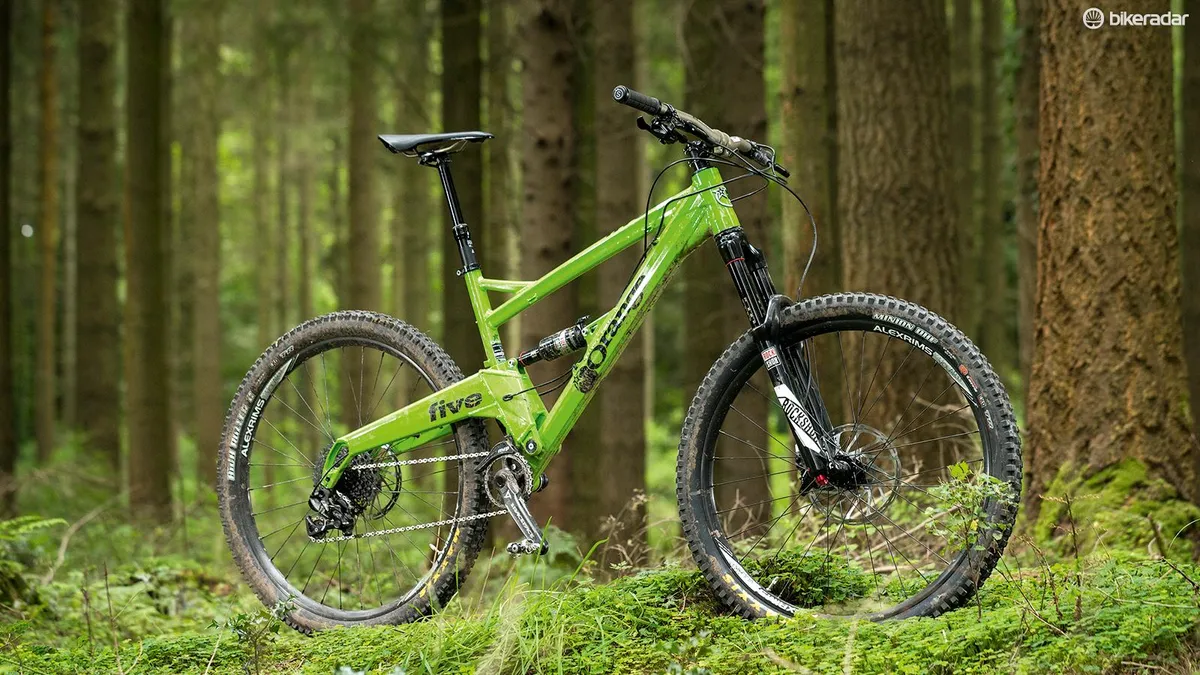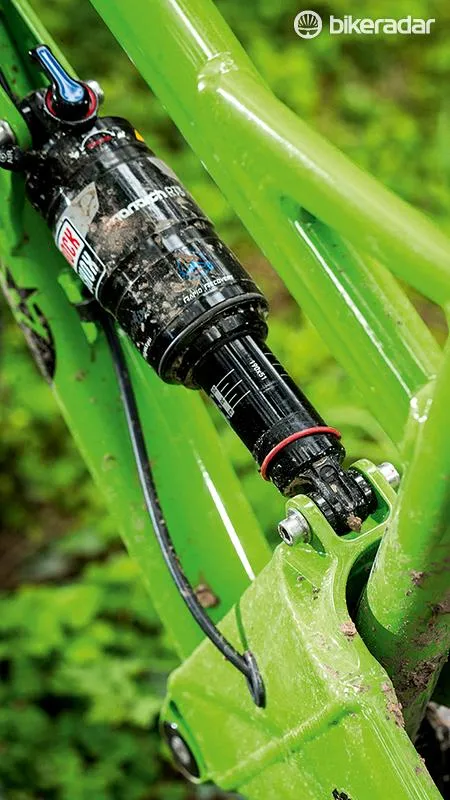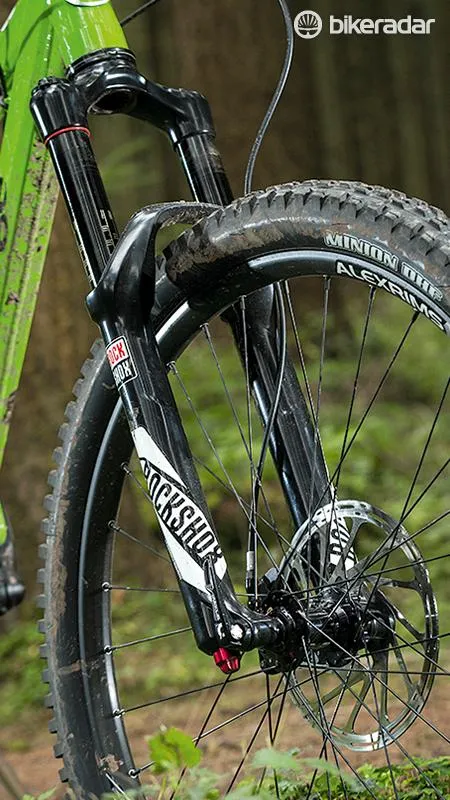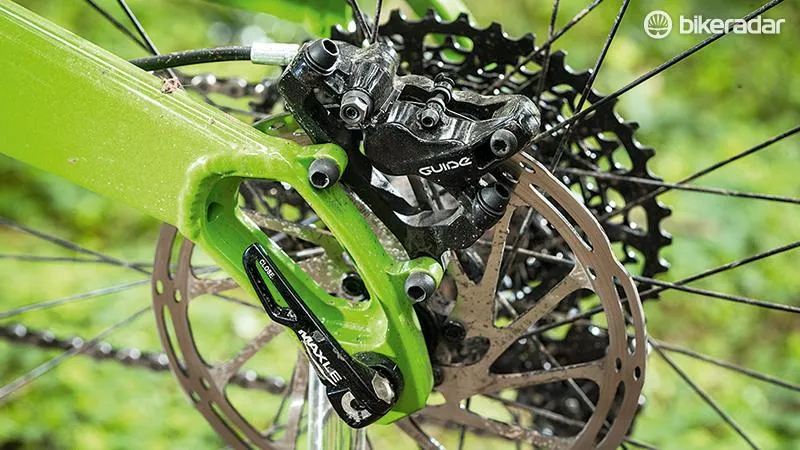The Orange Five is a British mountain biking icon. From its inception as the Sub-5 at turn of the millennium, this simple single-pivoted trail bike has been a common sight on trails all over the country. Its distinctive design makes it instantly recognisable, and seems to give it an equal measure of lovers and haters.
Frame and equipment: simple systems and component conundrums
The core of the Five is its single pivot alloy swingarm, welded in a factory in Halifax, West Yorkshire. There’s none of the fancy multi-linkage, varying axle-path, virtual pivot point tomfoolery going on here – it’s just a simple system consisting of a pivot and shock linking the front triangle to the swingarm at the back.
This has its advantages too. With only one pair of bearings to worry about, servicing is as easy as it comes. It also makes the system easier for Orange to construct, with less design parameters to work their metal folding jigs around.
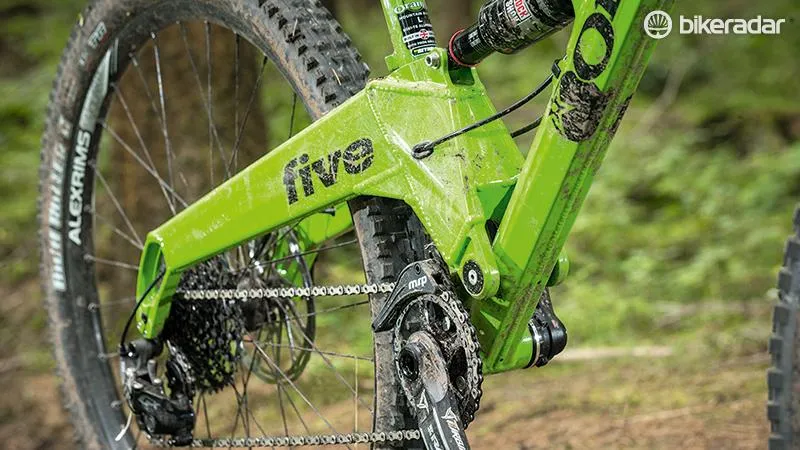
It might be simple, but Orange’s single pivot is a lot of fun
Single pivots still have foibles though, and the Five is no different. Brake jack, the stiffening of the rear suspension while braking, is noticeable, compromising traction on descents. Likewise, the impact of the suspension moving on the BB to rear axle length means there’s a hint of pedal feedback too. The Five also has a tendency to bob when pedalling out of the saddle, which costs energy under hard efforts.
Orange has tweaked the geometry for 2016. Half a degree has been shed from the head angle, 10mm has been added to the top tube and the wheelbase is now longer at 1200mm for a size large. Small changes maybe, but they add to the downhill bias that the Five has, adding to the happiness when terrain gets steeper and trails rowdier.
A bike is, of course, the sum of its parts, and Orange has done a mostly solid job when it comes to speccing the RS. The RaceFace Turbine crank comes with a 30t direct mount ring, which suits the spin-up-the-hill nature of the Five, while SRAM’s GX shifting and a MRP chain guide keep the drivetrain in check.
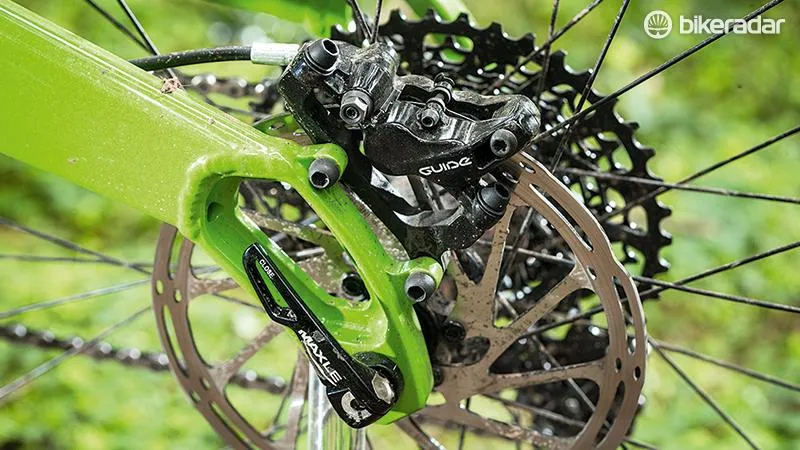
Guide R brakes might not be top of the tree, but they’re capable stoppers
Hope hubs laced into Alex Volar rims might not be super light, but they’re well built, and they give a decent profile to the tyres. SRAM Guide R brakes may be bottom of the Guide line-up, but they perform well, with decent lever feel and plenty of power for most applications thanks to the 200/180mm rotor combo.
It’s great to see a full Renthal cockpit – the 780mm bars offer plenty of leverage to hoick the bike around tight corners, or control flat out speed when stability is king. Our only real issue was with the KS Lev Integra, which isn’t our first-choice post. After only a week or so of riding, it needed a helping hand to return to full height.
Ride and handling: makes up on the downs what it loses on the ups
It’s important not to dwell too heavily on minor niggles though – the proof is in the riding. At times, at least, it’s where the Five excels. The Five has perhaps always been popular thanks to its happy-go-lucky attitude when the trail points down, and the latest incarnation takes this and runs with it.
While the suspension does stiffen under braking, it leaves the Five pitter-pattering and skipping over bumps in an involving and grin-inducing way. The top-line RockShox Pike RCT3 Solo Air fork at the front works well with the triple compound, tubeless ready Maxxis Minion DHF to keep your front wheel going just where you want it, meaning you can let it all hang loose at the back without too much risk of you being spat in to the undergrowth.
With the brakes off, the RockShox Monarch RT3 DebonAir is supple, happily soaking up the chatter while still delivering the controlled performance when the impacts grow. The Rapid Recovery rebound circuit helps glue the rear wheel to the ground, when braking allows.
The active suspension is more than happy being compressed into a berm too, allowing you to hold more speed than you might otherwise think is feasible. The Five just sits into its travel and waits for you to fling it out of the turn and into the next section. That said though, there’s a definite hint of flex between the front and rear of the bike. The bearings might be oversized, but with only one pivot point the bike does bend a little. Orange has tackled this as much as it can within the frame’s design though, new profiling of the front triangle’s tubes adding a claimed 15 percent increase in stiffness.

Point the Five RS down a hill and you're in for some fun…
In an ideal world, all we’d do is go down a hill, but unfortunately hills are also there to be ridden up; not every trail lets gravity do all the work. Here, the Five loses a bit of its shine. The slack angles and active suspension mean that it can feel a little sluggish when you’re traversing hills. Without a multi-link suspension system providing anti-squat chain tension the Five can suck a bit of life out of spirited efforts.
When the trail heads up and weight shifts back, it can feel like you’re sat quite far back on the bike too, needing a conscious effort to lower your torso towards the stem to keep it all in check. At 13.8kg, it’s no flyweight for this sort of money either.
Oh yes, did we mention the price? For this sort of money we’d expect a Guide RSC or Ultimate brake, and while the performance of GX is pretty much as good as the groups above, we’d feel it would have been better value if it came with X01, for example.
If parts of the spec really aren’t to taste, Orange does offer a range of upgrades at the point of purchase though, so Guide RS brakes or a RockShox Reverb post can be fitted for a relatively reasonable price.
All considered, the Five has retained its crown as one of the most fun bikes out there to shred down a hill. It may not be the most advanced and it is a bit of a slog to get it back up – but if you just want a massive grin when at to the bottom of the hill, the Five’s hard to beat.
